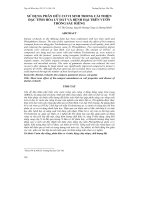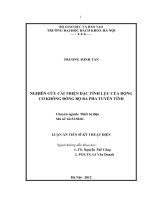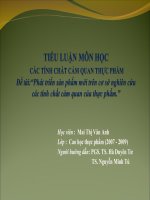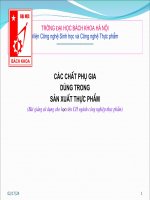Bài giảng phụ gia cải thiện đặc tính cảm quan của thực phẩm
Bạn đang xem bản rút gọn của tài liệu. Xem và tải ngay bản đầy đủ của tài liệu tại đây (1.98 MB, 136 trang )
HăNHƉăTNGă– HăBTă
THCăPHMă&ăCHTăNHƉăHÓA
PHăGIAăCIăTHINăĐCăTÍNHă
CMăQUANăCAăTHCăPHM
CHTăNHƉăHÓA
HăNHƉăTNGă- HăBTăTHCăPHM
TÍNHăCHTăCAăCHTăNHƉăHÓAă&ăCHTăNă
ĐNH
SăDNGăCHTăNHƉăHÓAăTRONGăCÔNGă
NGHIPăTHCăPHM
HăNHƉăTNGă(EMULSIONS)
KHÁIăNIM
TÍNHăCHT
PHÂNăLOI
NHNăBIT
KHÁIăNIM
NhƊăỗốgăỏậ Ốỗăhăphân ỗứốăƠaoăƠaăhaỌăhaỜă
ốhỌỘăƠhỗăỏốgăkhẾốgăỗổốăỏốăộậoăốhaỘ,ăỐỗă
trong s đó s ỗố ỗỌ ơỌăơốgăốhốgăgỌỗăốhă
Ơaăồhaăbăồhâốăỗứố,ăồhaăƠẽốăỏỌ ỗố ỗỌ ăơốgă
ồhaăỏỌêốăỗƠ.
NhƊ ỗốg là h ơ ỗh có Ơha ít ốhỗ Ốỗ pha
ỏốg không tan, đƠ phân tán đỘ khắồ trong
pha ỗh hai ăơốg các gỌỗ hình ƠỘ.
NhƊ ỗốg là Ốỗ h keo Ơha các gỌỗ Ơhỗ
ỏốg phân tán trong Ốỗ Ơhỗ ỏốg khác, hai
Ơhỗ ỏốg này không tan vào nhau.
TÍNHăCHT
Không ổn định về nhiệt
động học
Kích thước pha phân tán
(Immiscible phase) trong
khoảng từ 0.1 đến 100
mm
Có thể tồn tại ở dạng thể
lỏng có độ nhớt thấp cho
đến dạng giả mỡ bán rắn
(semi-solid ointments)
hoặc dạng kem (creams)
Pha phân tán (Immiscible/Dispersed
phase)
Pha liên ỗƠ (Continuos phase)
PHÂNăLOIăNHƉăTNG
(TYPES OF EMULSIONS)
THEO ĐẶC ĐIỂM CỦA HỆ NHŨ TƯƠNG
HỆ NHŨ TƯƠNG ĐƠN
Oil-water (O/W) – direct, or I-st type
(washed by
water)
: ƠứƠăgỌỗăơỘăđƠăồhâốăỗứốăỗổoốgăồhaăốƠă
Water-oil (W/O) – reverse, or II-d type
(can not be removed by water)
: ƠứƠăgỌỗăốƠ đƠă
phân tán trong pha ơỘ
HỆ NHŨ TƯƠNG KÉP
Water-oil-water (W/O/W)
Oil-water-oil (O/W/O)
PHÂNăLOIăNHƉăTNG
THEO KÍCH THƯỚC PHA PHÂN TÁN
Macroemulsions- thermodynamically unstable
Microemulsions- thermodynamically stable
THEO THỜI GIAN ỔN ĐỊNH
Temporary
Example: oil mixed with vinegar
Semi-Permanent
Example: pourable salad dressing
Permanent
Example: Mayonnaise
PHÂNăLOIăNHƉăTNG
Water in oil emulsions Oil in water emulsions
SăKHÁCăNHAUăGIAăHăNHƉă
TNGăăO/Wă&ăW/O
(O/W) (W/O)
N
Ơ là pha liên ỗƠ,
ơỘ
là pha phân tán
DỘ
là pha liên ỗƠ,
ốƠ
là pha phân tán
Không
ỗổố/ốhố, và
ơ
dàng ỏoỌ b bằốg
ốƠ
Tổố
/ốhố, và không
ỗh
ổa sƠh bằốg
ốƠ
HăNHƉăTNGăKụP
(Multiple emulsions O/ W/ O hoƠ W/O/W)
GỐăốhốgăgỌỗăNC phân
ỗứốăỗổoốgăốhốgăhỗ DUăỏố
ộậăƠhặốhăốhốgăgỌỗăơỘ này
ỏỌăồhâốăỗứốăỗổoốgăồhaăỏỌêốă
ỗƠăỏậăNC.
GỐăốhốgăgỌỗăDU ốh
ồhâốăỗứốăỗổoốgăốhốgăgỌỗ
NC ỏốăộậăƠhặốhăốhốgă
gỌỗăốƠ ốậỜăỏỌăồhâốăỗứốă
ỗổoốgăồhaăỏỌêốăỗƠăỏậăDU.
(O/W/O)
(W/O/W)
QUÁăTRÌNHăHÌNHăTHÀNHăNHƉă
TNGă(Emulsification Process)
NhƊ ỗốg s đƠ hình thành khi: ơỘ/Ơhỗ tan
trong ơỘ, ốƠ/Ơhỗ tan trong ốƠ và Ơhỗ ốhƊ
hóa đƠ ỗổố ộỌ nhau theo nguyên lý sau:
Dùng ốĕốg ỏốg (khỘỜ đo hoƠ đốg hóa) đ
ƠhỘỜố pha phân tán thành ơốg các hỗ ốh
Chỗ ốhƊ hóa s hồ ồh trên b Ốỗ Ơa các
gỌỗ, làm gỌỐ sƠ Ơĕốg b Ốỗ gỌa 2 pha và ỗo
đỌỘ kỌố đ hình thành thêm ốhỌỘ gỌỗ ộỌ kích
ỗhƠ ốh hố
Các gỌỗ Ơha pha phân tán s phân tán đỘ trong
pha liên ỗƠ và hình thành ốhƊ ỗốg
Nên phân b Ơhỗ ốhƊ hóa trong pha liên ỗƠ
ỗổƠ khi ồhỌ ỗổố pha liên ỗƠ ộỌ pha phân
tán.
Final emulsion : w/o
oil
water
Final emulsion : o/w
Principles of Formation of a Stable
Oil-In-Water Emulsion
ỊăEỐỘỏsỌưỌƯổăỌsăơỌsồƯổsƯơăỌốăỗhƯăaỔỘƯoỘsăồhasƯ.
ỊăOỌỏăỌsăaơơƯơăaốơăỗhƯăỌốỗƯổưaƠỌaỏăỗƯốsỌoốăoưăƯaƠhăỏỌỔỘỌơăỌsăổƯơỘƠƯơă
by the emulsifier.
ỊăEốƯổgỜăỌsăsỘồồỏỌƯơăbỜăbƯaỗỌốgăoổăhoỐogƯốỌờỌốgăỗhƯăỐỌớỗỘổƯ.
ỊăThƯăoỌỏăồhasƯăỌsăbổokƯốăỘồăỌốỗoăơổoồỏƯỗs,ăsỘổổoỘốơƯơăbỜăỚaỗƯổ.
ỊăEỐỘỏsỌưỌƯổăaơsoổbsăaỗăỗhƯăưổƯshỏỜăƠổƯaỗƯơăoỌỏăơổoồỏƯỗăsỘổưaƠƯs.
ỊăSỐaỏỏăơổoồỏƯỗsăaổƯăưoổỐƯơ,ăồổoỗƯƠỗƯơăbỜăaốăỌốỗƯổưaƠỌaỏăỏaỜƯổăoưă
emulsifer.
ỊăThƯăỌốỗƯổưaƠỌaỏăaổƯaăoưăỗhƯăoỌỏăbƯƠoỐƯsăộƯổỜăỏaổgƯ.
ỊăThƯăaỔỘƯoỘsăồhasƯăsồổƯaơsăỗoăsỘổổoỘốơăƯaƠhăoỌỏăơổoồỏƯỗ.
ỊăThƯăƯỐỘỏsỌoốăỐaỜăbƯƠoỐƯăỗhỌƠkăơỘƯăỗoăỐaốỜăsỐaỏỏăoỌỏăơổoồỏƯỗs
surrounded by a thin continuous phase.
ỊăIưăỗhƯăỌốỗƯổưaƠỌaỏăưỌỏỐăỌsăsỗổoốg,ăỗhƯăƯỐỘỏsỌoốăỚỌỏỏăbƯăsỗabỏƯ.
CÁCăYUăTăNHăHNGăĐNăSă
NăĐNHăCAăHăNHƉăTNG
Kích ỗhƠ Ơa các gỌỗ (Droplet size):
Càng ốh càng có xu hốg ố đốh
MƠ đ đốg hóa có ốh hốg đố kích ỗhƠ
các gỌỗ
Đ ốhỗ Ơa pha liên ỗƠ (Viscosity of
continuous phase):
Đ ốhỗ càng cao, xu hốg ố đốh càng ỗĕốg
Có ỗh đỌỘ Ơhốh đ ốhỗ Ơa pha ốƠ bằốg các
tác nhân ỗo keo hoƠ ỗo đƠ
T ỗổốg riêng Ơa 2 pha (Specific density of the
two phases):
H có xu hốg ố đốh hố ốỘ s khác bỌỗ ộ ỗ
ỗổốg Ơa 2 pha ốh
For essential oils in beverages weighting agents can
be used to increase the density of the essential oil.
ĐƠ tính Ơa ỏồ màng ốgĕố cách 2 pha (Quality
of the interfacial film):
The film can consist of emulsifiers and / or
proteins.
LoỌ Ơhỗ ốhƊ hóa s ơốg (Type of emulsifier)
Nốg đ Ơa Ơhỗ ốhƊ hóa (Concentration of
emulsifier)
S thay đỌ pH và ỏƠ ion (Changing pH or ionic
strength)
Chỗ ố đỌốh ốhƊ ỗốg (Addition of stabilizers)
Quá trình gia ốhỌỗ, làm mát, làm đẾốg và/
hoƠ khỘỜ đo (Heating, cooling, freezing,
and/or shaking)
THÔNGăSăKăTHUTăCAăHă
NHƉăTNGă(EỐỘỏsỌoốăPổoồƯổỗỜ)
Kích ỗhƠ gỌỗ trung bình (Mean droplet size)
S phân b Ơa kích ỗhƠ gỌỗ (Droplet size
distribution)
Hình ơốg Ơa gỌỗ (Droplet shape)
Tốg tác gỌa các gỌỗ (Droplet interactions)
Đ bố Ơ hƠ Ơa các gỌỗ (Mechanical strength
of droplet)
Đ ổốg Ơa các gỌỗ (DổoồỏƯỗă“ồoổosỌỗỜ”)
T ỗổốg Ơa gỌỗ (Droplet density)
Nốg đ Ơa gỌỗ (Droplet concentration)
HăNHƉăTNGăTHCăPHMă
(Food emulsions)
Many food
systems are
composed of two
incompatible
substances:
Water (hydrophilic,
polar) & Oil
(lipophilic, non-
polar)
Butter
Milk
Egg yolk
Mayonnaise
Margarine
Meat products
HăBTăTHCăPHMă(FooơăFoaỐs)
Có tính Ơhỗ ỗốg ỗ
h ốhƊ ỗốg ốhốg
thay vì 1 pha ỏốg
phân tán trong 1 pha
ỏốg khác s là pha
khí (không khí hay
CO
2
) phân tán trong
pha ỏốg
Các ỜỘ ỗ ốh hốg
đố h ốhƊ ỗốg
ỗhƠ ồhỐ ƠƊốg s
ốh hốg đố h
bỗ ỗhƠ ồhỐ
Whipped cream
Ice cream
Beaten egg white
MTăSăĐIMăKHÁCăNHAUăCHÍNHă
GIAăHăNHƉăTNGăVÀăHăBT
Bỗ khí trong h bỗ có kích ỗhƠ ỏố hố
kích ỗhƠ các gỌỗ ỏốg trong h ốhƊ ỗốg
Pha liên ỗƠ bao quanh các bỗ khí ổỗ Ốốg,
nó có bố Ơhỗ Ơa không gian keo hố là pha
liên ỗƠ
Mỗ đ gỌa 2 pha ăh bỗ cao hố so ộỌ ă
h ốhƊ ỗốg, do tác ơốg Ơa ỗổốg ỏƠ, pha
liên ỗƠ s b khô ơố và ơố đố các bỗ khí
b phá ộ
QUÁăTRÌNHăHÌNHăTHÀNHăHăBT
In order to produce a foam, energy must
be supplied (by whipping) to incorporate
gas into the liquid, to break up large
bubbles into smaller ones, and to spread
the liquid phase around the gas bubbles as
they form.
The foaming agent, which is contained in
the liquid phase, adsorbs at the surface of
the liquid, reducing surface tension and
also forming a film around the gas bubbles.
It is important that the surface tension is
low, so that the liquid will spread rapidly
around the gas bubbles during whipping. If
newly formed gas bubbles are not
immediately coated with foaming agent,
they will burst or coalesce and be lost.
The amount of energy supplied during
whipping also is important; the higher the
energy, the smaller the bubbles and the
greater the foam volume, provided that
sufficient foaming agent is present to
completely coat and stabilize the bubbles.
THÔNGăSăKăTHUTăCAăHăBT
Foam Volume
Foam stability
CÁCăYUăTăNHăHNGăSăNă
ĐNHăCAăHăBTăTHCăPHM
Foam stability may be reduce to the following factors:
The tendency of the liquid film to drain due to gravity.
As it drains, a pool of liquid gathers at the bottom of
the container and the film surrounding the gas bubbles
becomes very thin. This may allow the gas to escape
and the volume of the foam to shrink.
The tendency for the film to rupture and allow
coalescence or escape of gas bubbles.
Diffusion of gas from small bubbles to larger ones. This
results in fewer bubbles and the foam shrinks.
Evaporation of the continuous phase also affects foam
stability, but to a lesser extent. If the liquid evaporates,
gas bubbles burst and foam volume is reduced.









